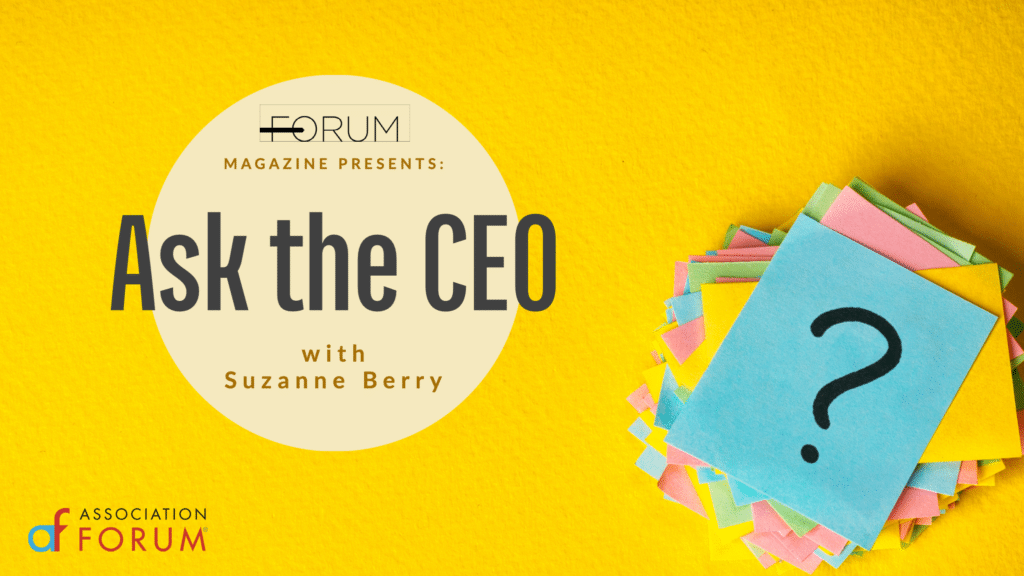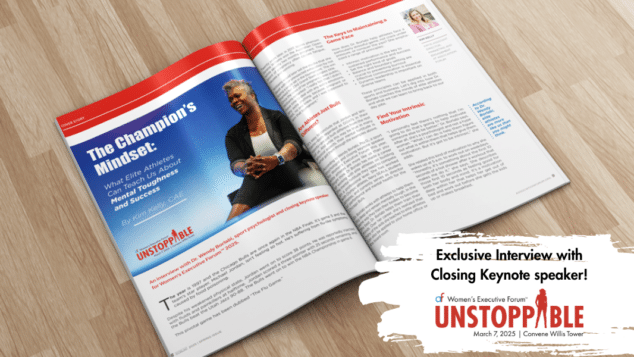Ask the CEO: HR Benefits & Flexibility

In this video, Suzanne Berry, Interim President & CEO of Association Forum, tells us how association executives can craft flexible benefits to serve their employees. If you prefer to read the transcript, scroll down for the full text.
Video Transcript
Suzanne Berry: Hello, everyone. I’m Suzanne Berry. I’m the Interim President and CEO of Association Forum. And I’m delighted to participate today in Ask the CEO.
How can leaders craft benefits that serve their employees?
Suzanne Berry: I love this question. How leadership teams can set employee policies for their organizations. And I think that I have maybe a unique perspective on this. I’m a woman who started in the business world in the late ’70s after finishing graduate school. I was one of few women in that graduate school MBA program. And when I started my career, I thought honestly that I probably could not and would not have a family, because I didn’t think the business environment at that point was welcoming to that. And so it wasn’t really until the early ’80s when I seriously began thinking about a family. That I wondered how I would going to do that. There certainly weren’t the policies and the practices in those days that was welcoming to a two couple working family where the woman was a professional, as well as her spouse.
And so I had the maximum him six week leave. My husband had no leave. Therefore, he couldn’t be part of that very short bonding time. There was not the technology available then to be able to do remote work. There were no computers. There were computers back then, but you couldn’t work at home with your computer. That gave me, I think, a unique perspective when I had the opportunity to make a difference in the lives of families who were thinking about having children and had children. What could I do as an employer to make both the workplace and their home environment in raising a family possible and enjoyable experience?
Early on in beginning of business, we formed an association management company back in the early ’80s. I left the corporate world. Joined our company. One of the things that I first did was design a program called Reduced Workload, so that women who were working for us could reduce their schedule. Still have their professional job, but be available to their kids when they came home from school, as an example. We did job sharing, and we created our employee benefits to be able to give the advantage of families and provide benefits to them. So, that we paid for part of their family benefits, and we tried to do what we could as a young company … as a new company, to try to attract talent.
Keep in mind that our business was state-focused at that time in Connecticut. And so we were competing against the insurance industry, who had very, very rich employee benefits. We wanted the best staff, and the way we were going to do that to recruit, to attract, and retain that staff was to be competitive in any way possible that we could. Maybe it wasn’t always providing the richest dental program, but it was providing the most flexibility in terms of their job. And instead of having sick time and vacation time, we called it personal time.
You could use that time in whatever way that you wanted. If you needed a doctor’s appointment, or you needed to go to a kid’s school program, you could do that with the personal time. So, you managed that yourself. We gave a large amount of time off, and you could manage that it in whatever way was most important to you. If you are single, maybe you used it for vacation time. If you had children, maybe you used it for some of your kids’ school activities. We really did not want to create an environment where staff had to choose between work and their families. We tried to create an environment where they could do both.
What are some resources and tools organizations can use in this area?
Suzanne Berry: I’ve always believed that you need to take advantage of a crisis. And COVID certainly presented a crisis. I feel opportunity for employees to prove that, in fact, you can work remotely. You can be successful. You can move your goals and objectives forward. As I think about the world going forward, I believe we will not go back to a situation where you’re going to be in the office five days a week. As an employer, I feel that you can manage your employees by really having clearly-defined goals and objectives. What does that mean? That means that employees are going to have more and more flexibility. They’re going to be able to hopefully balance work and their life more realistically, and in a way that’s going to be positive for them in the work environment, as well as the home setting.
So, what does that mean? I feel it’s going to continue to mean flexible work schedules. It’s could also mean job sharing opportunities. And it also could mean being able to be available to your family at the times when you’re needed. And in this sandwiched generation that we’re in, where many of us … we’re taking care of elderly parents, plus had kids, this is going to be even more important. And we’re going to be able to get the best and brightest if we continue to be flexible, and listen to the staff in terms of what their needs are. I also feel that there are other things that employers can do. For example, in emphasizing fitness and wellness. Also, emphasizing access to EAP programs. There’s a lot of stress in this environment in both managing your work and life balance.
It ought to be encouraged that employees take advantage of these EAP programs, which is not a huge cost for employers. I really encourage listening to your staff, and finding out what it is that they need, and building your benefits program around that. Whether it’s a cafeteria-style program, where they can select different aspects of a program, or whether it’s another kind of benefits program. Listen to your staff. And also, I’m going to make it pay for Association Forum’s compensation in HR benefits survey. What a great resource. You can benchmark where you are currently as an employer and the benefits that you offer your staff against other associations. Other associations your size, larger. They’re your competition for your staff. And if you want to retain your staff, you need to understand what other employers are doing for their employees.
Tags
Related Articles
Refill Your Cup: Summer Wellness Tips for Busy Professionals
Discover simple, effective ways to recharge this summer so you can show up as your...
The Champion’s Mindset: What Elite Athletes Can Teach Us About Mental Toughness and Success
An interview with Dr. Wendy Borlabi, sport psychologist and closing keynote speaker for Women’s Executive...
Great Bosses, Greater Impact: Leadership Lessons that Stick
The best bosses leave more than instructions—they leave echoes of confidence, creativity, and leadership that...





